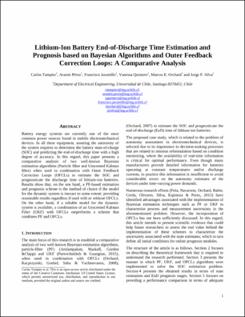Mostrar el registro sencillo del ítem
Lithium-Ion Battery End-of-Discharge Time Estimation and Prognosis based on Bayesian Algorithms and Outer Feedback Correction Loops: A Comparative Analysis
| dc.contributor.author | Tampier, Carlos | |
| dc.contributor.author | Perez, Aramis | |
| dc.contributor.author | Jaramillo, Francisco | |
| dc.contributor.author | Orchard, Marcos | |
| dc.contributor.author | Silva, Jorge | |
| dc.contributor.author | L. Quintero, Vanessa | |
| dc.date.accessioned | 2019-07-02T18:01:43Z | |
| dc.date.available | 2019-07-02T18:01:43Z | |
| dc.date.issued | 2015-08-24 | |
| dc.date.issued | 2015-08-24 | |
| dc.identifier.uri | http://ridda2.utp.ac.pa/handle/123456789/6156 | |
| dc.description | Battery energy systems are currently one of the most common power sources found in mobile electromechanical devices. In all these equipment, assuring the autonomy of the system requires to determine the battery state-of-charge (SOC) and predicting the end-of-discharge time with a high degree of accuracy. In this regard, this paper presents a comparative analysis of two well-known Bayesian estimation algorithms (Particle filter and Unscented Kalman filter) when used in combination with Outer Feedback Correction Loops (OFCLs) to estimate the SOC and prognosticate the discharge time of lithium-ion batteries. Results show that, on the one hand, a PF-based estimation and prognosis scheme is the method of choice if the model for the dynamic system is inexact to some extent; providing reasonable results regardless if used with or without OFCLs. On the other hand, if a reliable model for the dynamic system is available, a combination of an Unscented Kalman Filter (UKF) with OFCLs outperforms a scheme that combines PF and OFCLs. | en_US |
| dc.description.abstract | Battery energy systems are currently one of the most common power sources found in mobile electromechanical devices. In all these equipment, assuring the autonomy of the system requires to determine the battery state-of-charge (SOC) and predicting the end-of-discharge time with a high degree of accuracy. In this regard, this paper presents a comparative analysis of two well-known Bayesian estimation algorithms (Particle filter and Unscented Kalman filter) when used in combination with Outer Feedback Correction Loops (OFCLs) to estimate the SOC and prognosticate the discharge time of lithium-ion batteries. Results show that, on the one hand, a PF-based estimation and prognosis scheme is the method of choice if the model for the dynamic system is inexact to some extent; providing reasonable results regardless if used with or without OFCLs. On the other hand, if a reliable model for the dynamic system is available, a combination of an Unscented Kalman Filter (UKF) with OFCLs outperforms a scheme that combines PF and OFCLs. | en_US |
| dc.language | eng | |
| dc.language.iso | eng | en_US |
| dc.publisher | A Comparative Analysis. In the Annual Conference of the Prognostics and Health Management Society 2015 | en_US |
| dc.publisher | A Comparative Analysis. In the Annual Conference of the Prognostics and Health Management Society 2015 | |
| dc.rights | https://creativecommons.org/licenses/by-nc-sa/4.0/ | |
| dc.rights | info:eu-repo/semantics/openAccess | |
| dc.subject | particle filter | en_US |
| dc.subject | unscented Kalman filter | en_US |
| dc.subject | Battery discharge prognostics | en_US |
| dc.subject | particle filter | |
| dc.subject | unscented Kalman filter | |
| dc.subject | Battery discharge prognostics | |
| dc.title | Lithium-Ion Battery End-of-Discharge Time Estimation and Prognosis based on Bayesian Algorithms and Outer Feedback Correction Loops: A Comparative Analysis | en_US |
| dc.type | info:eu-repo/semantics/article | |
| dc.type | info:eu-repo/semantics/publishedVersion |
